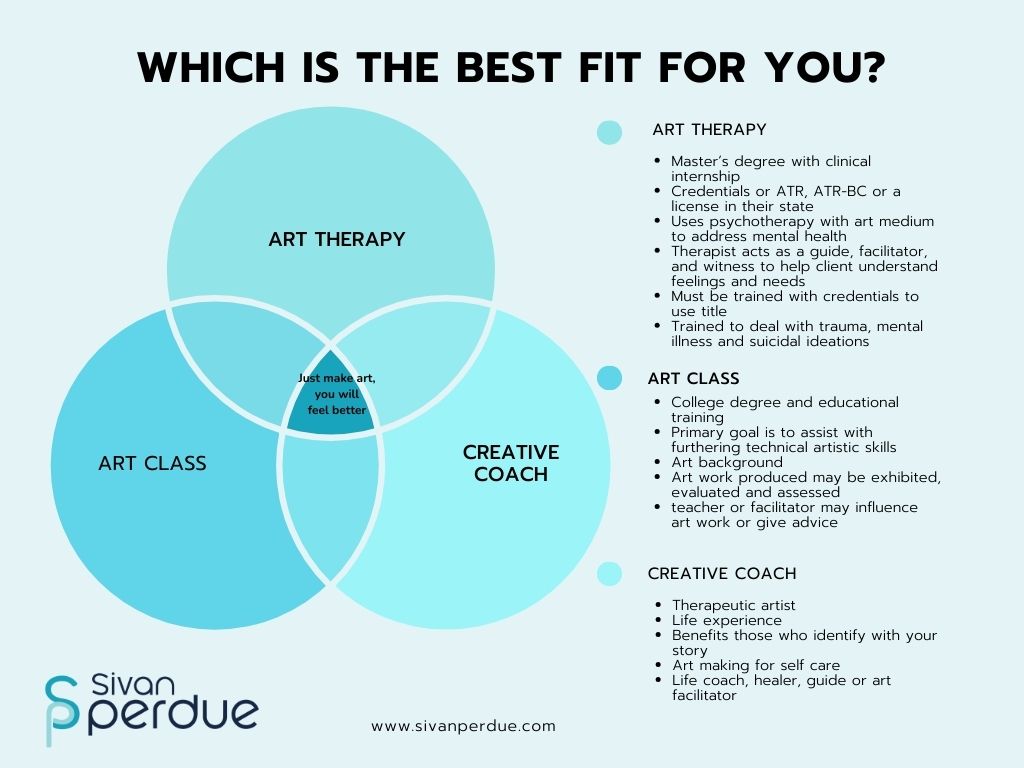Navigating the Canvas: Understanding the Differences Between Art Therapy, Art Class, and Creative Coaching
Creativity is being increasingly recognized as a powerful tool for personal growth and expression and there are a few avenues one can choose from to help you engage. Among these are art therapy, art classes, and creative coaching. While they all involve art in some form, each approach serves a distinct purpose and offers unique benefits. In this blog post, we’ll delve into these practices to help you understand their differences and how they can enrich your creative journey.
Understanding the Distinctions
While art therapy, art classes, and creative coaching all involve art and creativity, they serve different purposes and cater to distinct needs:
Art Therapy: Focuses on healing and self-exploration under the guidance of a licensed therapist.
Art Class: Provides structured instruction and skill development in various art mediums.
Creative Coaching: Empowers individuals to unlock their creative potential and achieve their goals through a collaborative coaching relationship.

Art Therapy: Healing Through Expression
Art therapy is a specialized form of therapy that utilizes the creative process to improve mental, emotional, and even physical well-being. It is guided by licensed art therapists who are trained to work with individuals dealing with a range of issues, including trauma, anxiety, depression, and relationship problems.
Unlike traditional talk therapy, art therapy encourages clients to express themselves through various art mediums such as painting, drawing, sculpture, or collage. The focus is not on the artistic skill or final product but on the process of creation and the emotions and insights it evokes.
Through art-making, clients can access deeper parts of themselves, explore unresolved emotions, and gain insights into their thoughts and behaviors. The therapeutic relationship between the client and the art therapist provides a safe space for exploration and self-discovery, leading to healing and personal growth.
Art Class: Learning and Skill Development
Art classes, on the other hand, are educational experiences focused on teaching artistic techniques, skills, and concepts. These classes can range from traditional mediums like painting and drawing to more contemporary forms such as digital art or mixed media.
Art classes are typically led by instructors who are artists themselves and have expertise in their chosen medium. They provide structured lessons, demonstrations, and feedback to help students develop their artistic abilities and expand their creative repertoire.
While art classes may offer some therapeutic benefits, such as stress relief and increased self-esteem, their primary goal is skill acquisition and artistic development. Students attend art classes to learn new techniques, refine their craft, and connect with other artists in a supportive community.
Creative Coaching: Empowering Personal and Professional Growth
Creative coaching blends elements of coaching, mentoring, and creativity to help individuals unlock their full creative potential and achieve their goals. Unlike therapy, which focuses on healing past wounds, creative coaching is forward-thinking and action-oriented, aimed at helping clients clarify their vision, overcome creative blocks, and take tangible steps toward their objectives.
Creative coaches work with clients from various backgrounds, including artists, writers, entrepreneurs, and professionals seeking to infuse more creativity into their lives and work. They use a combination of coaching techniques, creative exercises, and accountability to support clients in identifying their strengths, clarifying their goals, and overcoming obstacles.
One of the key distinctions of creative coaching is its emphasis on empowerment and self-discovery. Instead of providing answers or solutions, coaches encourage clients to tap into their innate creativity, intuition, and resourcefulness to find their own path forward.
Recent Comments